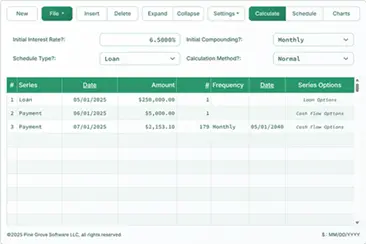Fixed Principal Payment Loan Calculator
What is a fixed principal loan?
A fixed principal loan is a loan where the borrower repays a fixed amount of the principal loan amount each period until they have fully paid off the loan. The interest on the loan is calculated based on the unpaid principal balance, which decreases over time as the borrower makes principal payments. A declining periodic payment due to a decreasing interest amount is one of the characteristics of a fixed principal loan.
In contrast, a traditional loan has fixed (sometimes called "level") periodic payments comprised of increasing principal and declining interest. The principal amount paid each period increases (to keep the same payment) because the interest amount decreases due to the declining principal balance.
- Why are fixed principal loans advantageous to borrowers?
- Fix principal payment loans reduce the interest amount paid because the borrower pays the principal loan amount off faster than they would if they had a traditional loan.
The Calculator-Calculate a Payment Schedule Using a Fixed Principal Amount
Information
Instructions for the fixed principal calculator
Enter the four primary inputs:
- Loan Amount: Enter the total amount of the loan you wish to take out. This should be entered as a positive number.
- Number of Payments: Enter the total number of payments you will make to pay off the loan. This should be entered as a positive whole number.
- Annual Interest Rate: Enter the annual interest rate for the loan, expressed as a percentage. For example, if the annual interest rate is 5%, you would enter "5" for this field.
- Payment Amount: Enter the amount of each payment you will make to pay off the loan. This should be entered as a positive number.
These secondary inputs must all be set. If you are not sure about any of them, we suggest that you leave them set to their default setting.
- Payment Frequency: Select the frequency of payments you will make to pay off the loan. This can be monthly, bi-weekly, weekly, or other intervals.
- Compounding: Select the compounding frequency of the loan. This is the frequency at which the interest is calculated and added to the loan balance. If the loan documents do not specify a compounding frequency or you don't know it, then set it to be the same as the payment frequency.
- Payment Method: Select the payment method you will use to pay off the loan. If the first payment is due when the loan originates set this option to "Advance." Otherwise, we'll assume the first payment is due one period after the origination date (when the funds are available) and in that case, this must be set to "Arrears."
These calculators also support "fixed principal" style loans and they are more feature rich as well. For example, with many you can set the dates and/or add extra payments.
If you try one of the above, just set the "Amortization Method" to "Fixed Principal."
Fixed Principal Payment Calculator Help
A fixed principal payment loan has a declining payment amount. That is, unlike a typical loan, which has a level periodic payment amount, the principal portion of the payment is the same payment to payment, and the interest portion of the payment is less each period due to the declining principal balance. Thus the payment amount declines from one period to the next. Ultimately, the borrower will pay less in interest charges with this loan method.
This calculator will solve for any one of four possible unknowns: "Amount of Loan," "Number of Payments" (term), "Annual Interest Rate" or the "Periodic Payment."
Enter a '0' (zero) for one unknown value.
The term (duration) of the loan is a function of the "Number of Payments" and the "Payment Frequency." If the loan is calling for monthly payments and the term is four years, then enter 48 for the "Number of Payments." If the payments are made quarterly, and the term is ten years, then enter 40 for the "Number of Payments."
Normally you would set the "Payment Method" to "Arrears" for a loan. Arrears means that the monies are lent on one day, and the first payment isn't due until one period after the funds are received.
If the first payment is due on the day the funds are available, then set "Payment Method" to "Advance." This is typical for leases.


Comments, suggestions & questions welcomed...